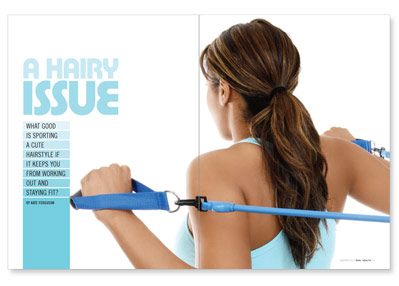
The findings from a recent Wake Forest University study may seem almost laughable: About a third of black women cite hair care difficulties as the reason they work out less than they would like—or why they don’t exercise at all.
But these findings aren’t amusing. African-American women are at a high risk of obesity and its many consequences. What’s more, African-American women have the highest rates of being overweight and obese compared with other groups in the United States. About four out of five tip the scales.
After the finding was published, the discussion began. Health care providers took notice and started considering the link between black women’s hair issues and physical activity—and how to find practical ways to address the problem.
One African-American woman, Jeanette, says she regularly exercises. But she also says if she has someplace to go, she won’t work out beforehand because she doesn’t want to ruin her hair. Jeanette’s biggest fashionable coiffure versus fitness challenge? The need to wash her hair so often. “It’s inconvenient because I work and don’t have a lot of time to redo my hairstyle,” she says.
But a lack of hair management time is only one of several key complaints cited by black women regarding their physical activity and hair care regimens. In an American Association of Retired Persons (AARP) consumer focus group report, black women said concerns about the high costs of hair care and damage from regular cleansings cooled them to exercising more often. To explore solutions to such problems, one health care company, UnitedHealth Group, teamed with Bronner Bros., the Atlanta-based company that produces annual beauty and hair industry trade shows. The result? An innovative hair fitness competition that challenged hairstylists to create the best fitness-friendly hairstyles for women.
“We have learned to have great respect for the African-American hair professional,” says Reed Tuckson, MD, the executive vice president and chief of medical affairs for UnitedHealth Group. “We’re helping them become much more capable and available to participate in the fight for health across the board in our community.”
Tuckson says his organization will continue to partner with community hairstylists in order to improve African-American women’s health.
“Hairstylists are people who have an incredibly intense and intimate relationship with their customers,” Tuckson says. “We are excited to help deploy them as an army of new health deputies who we believe can be very effective at creating much more health awareness in their customers when they come to the salon.”
Regarding women whose hair concerns keep them from exercising, Tuckson believes that hairstylists can show them how to better work with their tresses. The idea is to offer black women easy and convenient styles that’ll allow them to work out—and work up a sweat.
“This can also be the spur that’s needed to motivate women to engage not only in exercise, but to have positive attitudes about diet and lifestyle modifications that enhance their health,” Tuckson adds.
Elgin Charles, owner of a Beverly Hills hair salon, agrees with Tuckson. He thinks the initiative is a good way for stylists to educate their clients and teach them how to manage their hair before and after they exercise. This way, they don’t have to sacrifice their health to look attractive and well-groomed.
“This is a very serious issue in our community. A lot of us are unhealthy because we eat everything we want and avoid physical activity,” Charles says. “Worrying about your hair shouldn’t be a reason not to exercise.”
Work It Out!
Lose your hair-care fear.
Don’t let hair maintenance anxiety scare you away from exercise. These celebrity hairdressers teach health-conscious black women how to tame such terrors.
Afraid to stress your straightened or natural strands?
Try twisting or braiding your hair, says Elgin Charles, a Beverly Hills hairstylist. Occasionally heat-straighten your tresses? Before your workout, apply a thermal protectant, such as nuNAAT’s Karité Special Anti-Frizz Thermo Active styling cream, says New York hairstylist Ashley Hanna. Then, make pin curls and wrap hair. After your workout, blow-dry hair roots on medium heat then style. Another option? Wrap hair in sections around the head then tie with a silk or satin scarf. This preserves your hairstyle during a workout. Tresses locked? Wrap them too, Charles says.
Terrified because you wear a weave or extensions?
Treat these just as you would your natural hair. Weaves or extensions can do double duty because they allow you to rock a variety of styles while letting your real hair rest and rejuvenate.
Too spooked to swim?
First, wet hair with water then slather on conditioner. This stops hair from soaking up the chlorine in a pool or salt if you swim outdoors in saltwater. Put on a swim cap. Shampoo and condition hair after swimming. If you swim a lot, consider attaching a ponytail once you’re out of the water for a new daily look. It’s easy: Smooth your own hair back—use a curl-taming product if needed. Then attach the ponytail.
Scared about color-treated curls?
Apply another thermal protectant and color saver, such as Twisted Sista’s Blow Drying Creme, Hanna says. But the most important post-workout tip for African-American women with color-treated tresses, Charles says, is to keep hair moisturized.






Comments
Comments